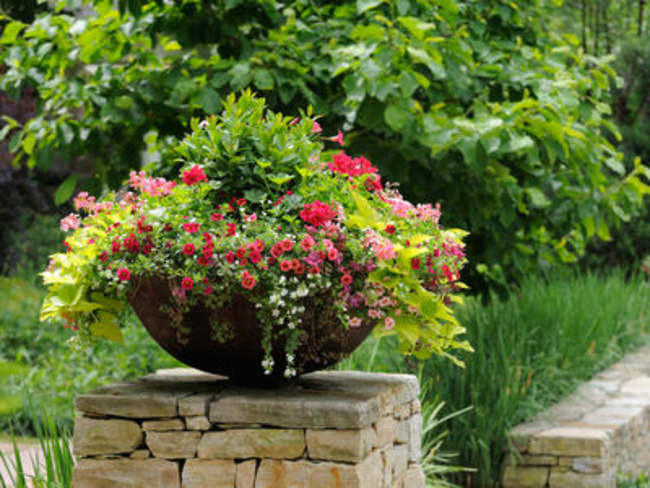Top 10 Container Gardening Tips
Containers and hanging baskets of all shapes and sizes can add brilliant colour and texture to your landscape. They can freshen up the front porch, add punch to your patio or add pizzazz to the poolside. The colors, textures and varying heights of flowers, plants, and accessories, (such as obelisks), provide an attractive contrast to the lines and architectural details of your hardscaping and add a focal point to any space. Container gardening is also a great way to be able to garden in small apartments or homes with no yards. Plants in containers can offer great versatility as they can be moved around and the containers themselves can add to your outdoor décor. The most important thing to consider when container gardening is choosing the right plants for your location. Plants have specific light preferences, so understanding how much sun your plants will get is essential to your gardening success. Observe the light in the area and select your plants accordingly… and don’t forget to fertilize and deadhead to ensure a nice, long bloom period.
1. Mulch matters
Pots with a single upright plant—say, a rosemary topiary or a large hosta—leave a great deal of boring soil revealed. A layer of attractive mulch, such as washed river stones, terra-cotta pebbles, glass marbles or sphagnum moss, adds a finishing touch and cuts down on water evaporation. (Remember to keep mulches away from plant stems.)
2. Get a lift
To add extra height, place a plastic rose collar (used to protect hybrid teas over winter) in the centre of a large container already filled with soil. Fill the centre of the collar with additional soil. Now you have two tiers to plant in. If the collar is visible after planting is complete, camouflage the plastic using a few clumps of moist sphagnum moss.
3. Show no soil
Plant closely, fully and generously so your containers look gorgeous from the get-go. Gently squeeze root balls into thin, narrow shapes to make room for more plants. Don't worry about the tight quarters: careful watering, quality soil, regular feeding and deadheading will keep your display in top shape.
4. More foliage, please
Garden designers always sing the praises of contrasting shapes, textures and shades of green found in foliage plants. In containers, use at least one-third foliage plants to set off flowering plants to best advantage.
5. Set the stage
When grouping different containers, raise a few at the back by placing them on bricks or upside down pots. Not only does this add height to your scene, it improves air circulation, too.
6. Less is more
The fancier, more ornate the container, the simpler the plant palette should be—a grouping of one type in a container can look sophisticated and dramatic. Even simpler: place a massive unplanted container—perhaps glazed Provençal blue or maroon—in a bed of groundcover under a shade tree to inject a punch of colour. Or centre an intricate obelisk (with no vines on it) in a container of low-growing plants to serve as a piece of garden sculpture.
7. Be bold
The farther away your container is from viewers, the bigger and bolder the flower and leaf forms should be. A mass of dainty bacopa<strong/> and Swan River daisies<strong/> in a pot next to your front door is a fuzzy blur when seen from the front sidewalk.
8. Cheat a little
For a special party, bump up the floral quotient by tucking floral picks (small plastic vials that hold water) filled with stems of gerberas<strong/>, dahlias<strong/> or roses<strong/> into window boxes and other containers.
9. Cue the understudies
For key containers, keep a few duplicate plants growing in pots elsewhere in the garden. Then, if one or two underperform or meet an untimely end, you can replace them with something identical. (Because you know if you go back to the nursery for a replacement, there will be none left!)
10. Trailers to the back
For a softer, more natural look, plant some trailing plants midway back instead of all along the edge. Let a few stems meander around the bases of upright plants before spilling over the edge.






